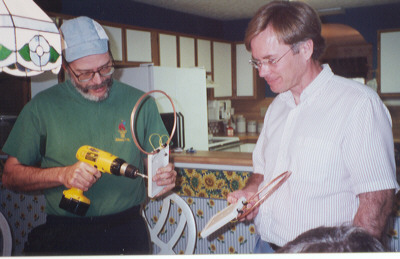Map, Compass, Radio Direction Finding, Thrills!
By Laurie Searle
After
a team of Georgia orienteers competed in the USA Amateur Radio Direction
Finding (ARDF) championships in Albuquerque last year, they needed a new
challenge. So they convinced the Georgia Orienteering Club to host the
2002 U.S. ARDF/Radio Orienteering Champs in Pine Mountain, GA, April
19-21, 2002.
Did
someone say “Challenge?
Let’s start with the event management. The Albuquerque event was similar to a USOF Convention, with five days of activities, room, board, and competition fees included in the package price. GAOC liked the idea of a package deal, but wanted the event to be more like an A-Meet. So it offered a package that included a practice event, 2 days of competitions, 2 evening meals, t-shirt, preview map, and parking passes, for $70. Items were also available a la carte, which gave the volunteers and guests more options.
Let’s
talk about volunteers. Thank heaven for our core group of GAOC volunteers
– Robin & Stephen Shannonhouse, Bill Farrell, Martha Carr, the Neher
family. But since this event used radio equipment, which we had to impound
before the start, we really wanted some folks with ham radio experience.
Many ham radio volunteers helped us out including Ron Smith, Tony &
Patty King, Henry Kelly, and Rick Mueller, from the South Fulton County
Amateur Radio Emergency Service; Sam Smith from the Bill Gremillion
Memorial Radio Club; Kevin Haywood and Charlie Siler from GAOC; and a host
of dignitaries from the Amateur Radio Relay
League.
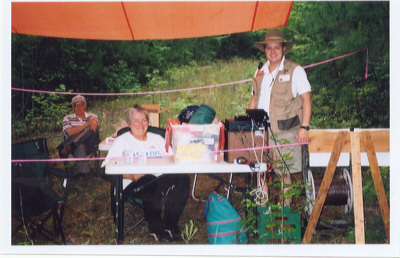 |
|
Martha Carr and Sam Smith working the start. |

How does ARDF Work?
The
object of the game is to find the transmitters using Amateur Radio
Direction Finding Equipment, which consists of the following components:
| Handheld radio or scanner that receives a designated frequency | |
| Signal strength meter to judge the relative strength of the
received signals | |
| Attenuator to reduce the strength of the received signal
| |
| Directional antenna (usually constructed)
| |
| Headphones or ear plugs to hear the signals |
| . |
| . |
|
|
|
Sam Smith and Kevin Haywood build 80 meter equipment. |
Each transmitter sends a simple Morse code pattern so that even non-radio operators can identify the transmitters by simply counting the “dits” at the end. When all five have transmitted, the cycle repeats.
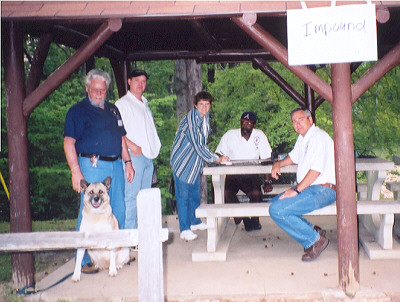 |
|
Volunteers from South Fulton Amateur Radio Emergency Service ran the impound area. |
Practice
Event
A perfect spring day and cheerful volunteers greeted competitors as they arrived for the morning practice session. With a spirit of show and tell, they couldn’t wait to unload their radio equipment and talk antennas, receiver kits, and signal strength with their competitive buddies. For those who were more orienteer than radio enthusiast, like Valerie Meyer from VA, Sam Smith had equipment on hand to loan.
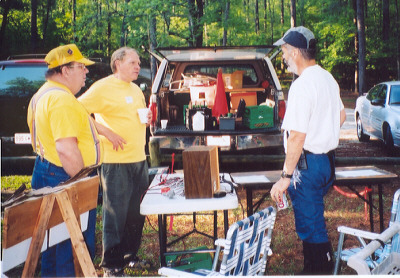
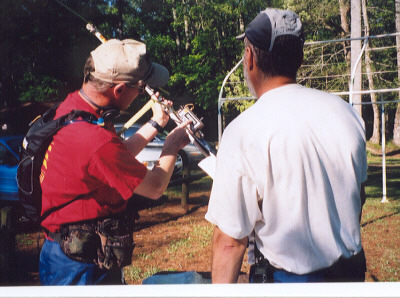
At
8:53, the first start sounded over the public address system in Olympic
style, “beep beep beep beep BEEP!” and the first competitor was called
up. At 8:55 the first competitor moved to station 2 and was given his
equipment and orienteering map. Here he would have three minutes to fix
the punch card, map and other accessories. At 8:58 the first competitor
moved to station 3 where he was instructed to turn his equipment on at the
next Olympic beep. At 9:00 the competitor turned on his equipment and
began sweeping for the signal on the way to the start triangle.
Competitors who had never run on one of Sam Smith’s courses were in for a bit of surprise. Unlike some ARDF courses, which stay close to trails and are set at a typical yellow / orange level, Sam set expert level courses at the green level. Competitors later said they were glad they took advantage of the practice courses to get used to the terrain and the course setter’s technique.
VHF
Competition
Twenty-six competitors were up with the dew in order to turn their equipment into the impound area by 8am. And with a short 20-minute walk to the start, they had plenty of time to plot their strategy.
 |
| Competitors discussed strategy at the Start. |
| . |
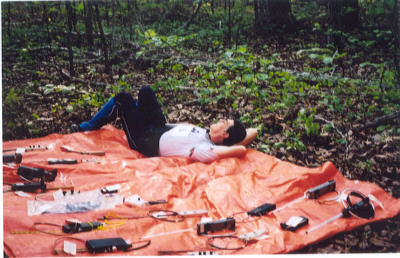 |
| Bob Frey grabs a quick 40 winks. |
Jackson
Stump from NM said he’d like to find at least one control and finish
under 2 hours.
William
Thomas from FL said he needed to keep contact with the map since the
terrain was so different that his home terrain in Florida.
Gyuri
Nagy from NY calculated the control placement based on the rules. “The
transmitter closest to the start should be at least 750m away. Minimum
distance between transmitters is 400m. Total course length from start to
finish via all transmitters, should be between 4-7km,” he recited from
memory.
Sergei
Storkov from AR planned to triangulate on the run within the first 5
minutes.
Many others shared a common strategy, “Find 1 control, don’t get lost, don’t’ drop the equipment.”
Gyuri Nagy set the bar high when he crossed the finish line on M21 at 95:00 and Charlie Siler on M50 was less than 5 minutes behind him at 90:22. Bill Farrell, M60 and Martha Carr, F50 also had personal bests at 84:38 and 126:55, and many others had personal bests and respectable times, considering the challenging course.
HF
Competition
After
the beating heat of Saturday’s competition, competitors were more
interested in drinking water than talking strategy, so I headed out to a
common control with Dale Hunt to take photos.
I
had never actually seen a radio orienteer in the field so I thought it
would be interesting to see if their actions matched their strategy. I
crouched down low when I heard the first competitor breaking through the
brush. He moved towards the control and stopped about 15 feet from its
location in a gully. He stood still and waited. And waited. And waited. A
minute when by and my leg started cramping. Still he waited. Another
minute when by and my foot was asleep. Then I heard a faint and welcome
sound - dahdah dahdahdah dit. The competitor perked up, homed in on the
signal, and immediately saw the control!
The blood returned to my leg just in time to spy Charlie Siler from GAOC approaching the control. Again I crouched low, hoping he would find it quicker than the last fellow. Charlie had a good line approaching the control but he couldn’t see it. He kept moving, and looking, and moving, and looking when there! He caught sight of it. Within seconds he had punched the control, took a quick glimpse at his map, and was out of there.
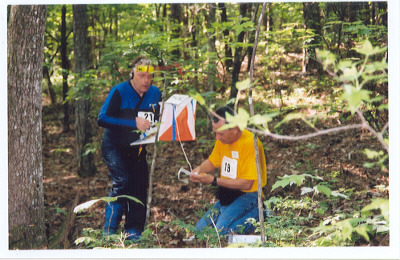
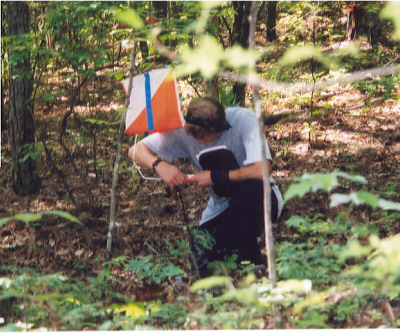
Competitors at the MOE control.
As
I observed more competitors, I made mental notes to check their finish
times when I got back. What I discovered was that those with the fastest
times came pretty close to the control location then continued moving
around and searching until they found the control. Their strategy seemed
to be, “keep moving.”
Awards and Rewards
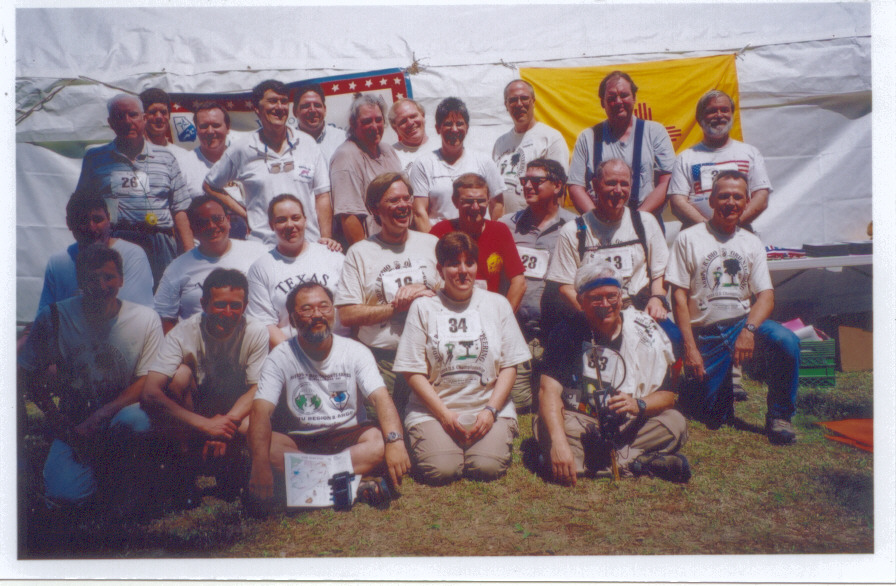
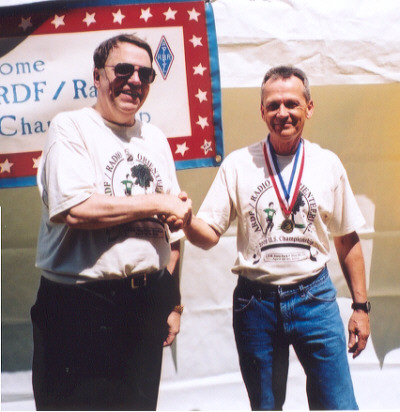 |
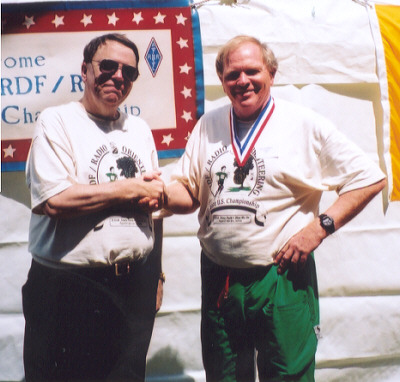 |
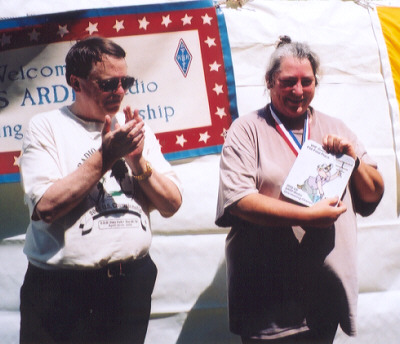 |
| GAOC gold winner Charlie Siler | GAOC gold winner Bill Farrell | GAOC gold winner Martha Carr |
Awards were typical of a USOF sanctioned championship. U.S. championship medals were awarded to those eligible in the top three places in each category for the VHF and HF competitions. And overall awards were awarded to the top three places in each category, which gave non U.S. citizens an opportunity to win. GAOC took home 5 gold medals thanks to the outstanding efforts of Charlie Siler, Bill Farrell and Martha Carr.
Rewards
were many. GAOC was first to put the term “Radio Orienteering” in the
name of an ARDF event and that led our strategy for shifting the focus and
raising the bar for the U.S. championships. IOF standard o-maps,
championship-level courses, GAOC hospitality – all of this gave
competitors the essence of orienteering. It is very exciting and rewarding
to participate in and help shape a sport in its early development.
Want to try radio orienteering?
The
great thing about radio orienteering is that you don’t need an amateur
radio license to try it. But you do need equipment. If you’d like to try
before you buy, check out one of the following websites. Folks usually
bring extra equipment to the scheduled meets and there’s always someone
on hand to give you instructions.
Georgia
Radio Orienteering: www.mindspring.com/~sam.smith/gro
Homing In: http://members.aol.com/homingin/
